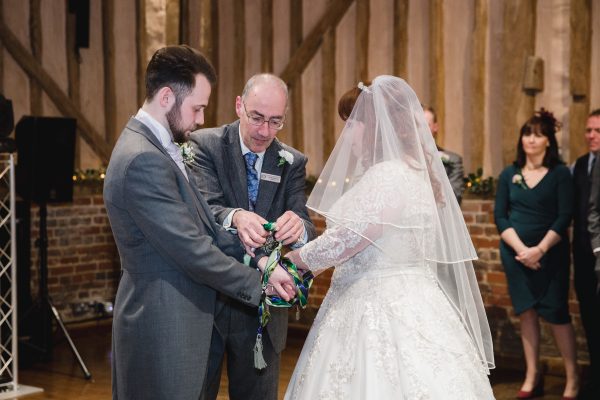
by Michael | Mar 7, 2018 | Blog
If you’re looking for a personalised wedding ceremony, you might like to include a ritual. It can make such a difference.
“Ritual” may possibly sound a bit too religious for some, but it could be something as simple as both drinking from a Loving Cup, or presenting parents with a red rose.
You may never have considered a handfasting ceremony. Actually, you may not have heard of one, either!
Assuming that you are basically unfamiliar with a handfasting, here is a bit of information that may clarify things.
Example of a handfasting

Photo: louiedonovanphotography.co.uk
Briefly, and simply: the couple take each other’s hands – left in left, and so on. The celebrant ties their wrists together and says suitable, beautiful words. After a while, the hands are untied.
In its simplest form, that is a handfasting.
Incidentally, this ritual is the origin of the expression “tying the knot” and indeed “bonds of holy matrimony”.
Origins
The ceremony probably originated in Celtic times; however, it flourished in Europe until the mid 1700s. Up till then, few unions were sanctified in a religious building like a church. Rather, they were celebrated by a simple handfasting ceremony in which the two partners joined hands over the village anvil, in the fields or in the groves of trees. Today, we build upon this tradition.
The basics
The couple link and cross hands (normally right hand to right, and left to left) to form an infinity circle. Then, with a cord or ribbon (or ribbons), the wrists are symbolically tied and knotted, in a lovers’ knot.
The cords are then removed with the knots still in place. The couple will take the cord away with them and, ideally, it will be a permanent reminder of their vows.
Where does this happen?
Again, it depends, but many people prefer a quiet, open-air historic site that may be considered to be spiritual and preferably pagan – such as standing stones.
What about Stonehenge?
A civil celebrant, such as myself, can conduct a handfasting wedding or vow renewal in the Inner Circle at Stonehenge (normally around dawn or dusk), but this needs to be booked months in advance. However, places like Avebury, Old Sarum or the Rollright Stones might be more practical.
A handfasting can comprise an entire ceremony in itself, but is often one element among many.
Breaking the Glass
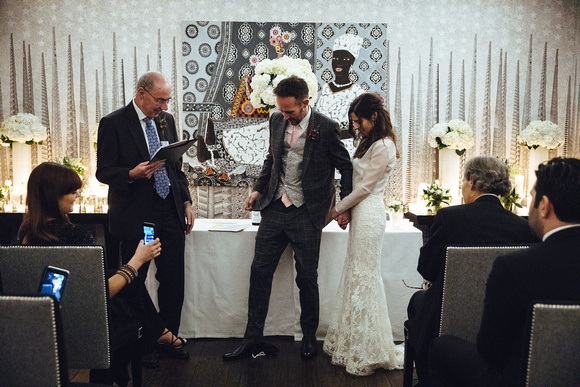
Photo: www.lyndseygoddard.com
Originally Jewish, this ritual is growing in popularity. There are many explanations for this. For example: it can recall the destruction of the Jerusalem Temple; serve as a symbolic reminder that things do break; and I have even heard that it is meant to be the last destructive thing to happen in the marriage.
Come what may, everybody enjoys shouting “Mazal tov!” when the deed is done!
Your civil celebrant will be able to help you learn more about rituals. Why not take advantage?
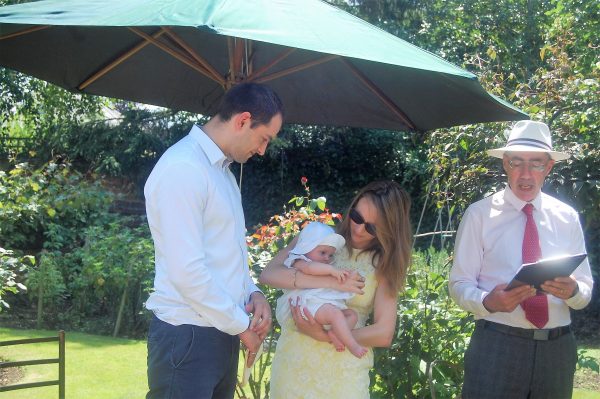
by Michael | Jan 30, 2018 | Blog
There are no guarantees about the weather anywhere. Living on an island like Britain, we are not particularly surprised by heat in winter, or rains and snow in summer. So who would dare arrange an outdoor ceremony?
A wonderful setting for a handfasting!Almost exactly four years ago, I was privileged to conduct a handfasting on an Iron Age fort that – as the picture above shows – was totally exposed. It was a period of exceptional floods across Britain. I drove down through torrential rain, and had to drive back through a thunderstorm. Amazingly, for the couple of hours I was up on Old Sarum (I had to be there early to set up), it didn’t rain and wasn’t even (very) cold.
I’ve officiated at a small number of outdoor ceremonies in the summer when the conditions were, shall we say, difficult. In one case, there was a sudden cloudburst during the wedding. Somebody had the presence of mind to bring a parasol from the hotel terrace to protect the bride (though not the celebrant!). On another occasion, a vow renewal, there was a yurt available, but the rains held off sufficiently, and we could stick to Plan A. On a third occasion, the day was cloudless and extremely hot for the naming ceremony. Fortunately, this was a garden event, and there were plenty of trees offering shade.
Sun
So what can you do, if the forecast is hot and sunny?
You can usually rely on some common sense on the part of your guests. They may bring a hat and maybe sunscreen etc.
You can make sure that plenty of cold drinks (preferably, not alcoholic at this stage) are available. Depending on the sort and size of ceremony and the venue, you may be able to offer parasols or small umbrellas for the guests. If shade is available, then make use of it. Finally, bring the guests out as late as possible, and keep the ceremony short, if that is feasible.
Wind
There’s not much you can do about wind, especially if your ceremony will be held at an exposed spot. One thing to be aware of is that wind will take sound away, so the celebrant’s voice, at least, will probably need to be amplified. Hats and veils will need attention, if they are not to be blown away.
Rain
When the rains are expected, you may be able to issue umbrellas to the guests. If there are seats, try and keep them covered with plastic, say, until the last moment.
If it’s muddy, perhaps the venue can put down some sort of (red?) carpet, so that heels don’t get submerged and trousers splashed.
Cold
Hopefully, guests will have the sense to arrive well-protected. It may be possible to issue blankets. If the length of the ceremony can be kept to a minimum, it might be appreciated by your guests.
Reality
Despite all this pessimism, of course, the chances are that the weather will be wonderful for your big day! And there’s nothing like having your ceremony outdoors – it really makes it special (just occasionally, for the wrong reasons, though!).
If your ceremony is in the grounds of the hotel, it’s worth chatting to them in advance, especially if adverse weather is anticipated. They may have a Plan B for you.
An outdoor ceremony? A gamble, yes – but one well worth taking.

by Michael | Jan 22, 2018 | Blog
Rituals can add dramatically to the atmosphere and spirituality of a ceremony. As a civil celebrant, I am often asked for suggestions as to items that can enhance the service.
I am going to leave out religious rituals, although I do readily incorporate some, especially in mixed-faith services. For one thing, there are rather a lot of religions to mention, and I only have a few hundred words at my disposal!
There is a whole range of rituals that may appeal, so, although I’m only covering a few here, please be aware that the list is by no means exhaustive.
Moreover, there are variants to most of the rituals, so there may not be a ‘right or wrong’ way of doing them.
Handfasting
Probably my most requested ritual is handfasting. You may not know that the expression “tying the knot” is derived from this. The couple take each other’s hands, left to left and right to right. To the accompaniment of suitable words, the celebrant knots the couple’s chosen ribbons or cords (often in an infinity sign).
The couple are soon released, but take home the knotted ribbon as a reminder of what they promised each other on the day.
A handfasting can be part of a full pagan ceremony, but it may just be a brief – but beautiful and meaningful – section of the service.
Unity Rituals
The Loving Cup (or “Quaich”) is another popular inclusion. Very simply, it is a goblet (usually with some wine in – not too much!) which bride and groom both drink from, one handing the goblet to the other in turn. It symbolises unity, of course.
An alternative is a sand ceremony. This is where two (or more, to include extended family/friends) phials of sand of different colours are together poured into a bigger vial.
Similarly, you can have a Unity Candle, and two (or more) people light it with tapers.
All these actions are accompanied by appropriate words by the celebrant.
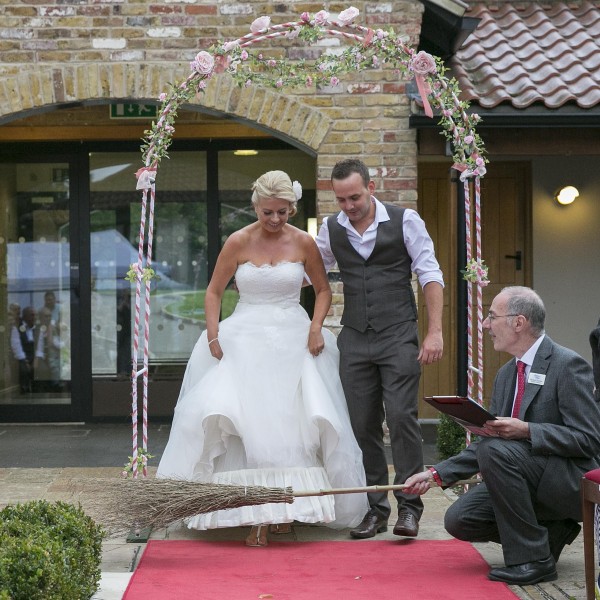
Jumping the Broom
There are various origins to this ceremony, but it involves the couple jumping over a besom (a sort of witch’s broom). The new home symbolism (sweeping out the old) is fairly evident, but it can have the extra element of introducing a bit of humour to the proceedings.
So these add-ons, or others like them, can make a real difference to the atmosphere of the ceremony.
Naturally, if you want to explore this any further, do feel free to let me know.
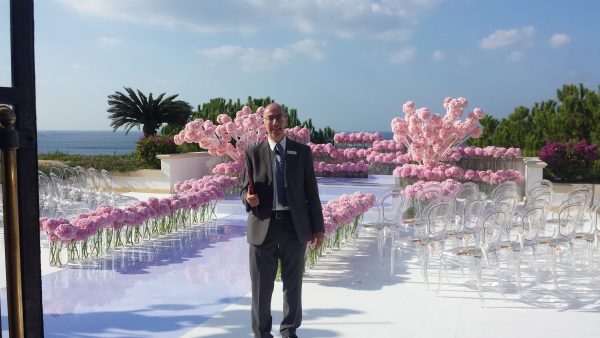
by Michael | Dec 28, 2017 | Blog
As another year comes to an end, it‘s only natural to look back. What has been especially memorable? What has stood out?
Every ceremony is different, of course, so it’s impossible to compare like with like. However, I did my first destination wedding in September, so perhaps it is inevitable that I mention that.
Destination Wedding
A lot of work went on in this country beforehand – starting with my rigorous interview (or, actually, interviews). Once the groom had met and approved me, it was the turn of the bride. During that meeting, a recording of me reading was made, and sent off to her parents. Eventually, I received the green light.
This was a five-star wedding in Cyprus. The groom was a South African-born Jew, and the bride Russian Orthodox. In fact, religious content turned out to be minimal, but I needed to be able to address the Russians in an acceptable accent (hence the recording at interview).
The venue (Hotel Anassa), about 1.5 hours from Paphos was a stunning location, and no expense was spared. For reasons of confidentiality, the only photo I can show was of me (flowers – and the wonderful ocean backdrop) before we started (see picture above).
Handfastings
Other ceremonies were less glamorous, perhaps, but nonetheless enjoyable. I particularly think of two, both handfastings.

Source: louiedonovanphotography.co.uk
The first was at Lillibrook Manor, which has a fabulous half-timbered barn and, indeed, wonderful atmosphere. A room was even set aside for me to prepare in, which is most unusual in my experience. The couple were so kind, considerate and warmth glowed from them that it was impossible not to be carried away with the whole ceremony. (I had to make sure I kept my mind on what I was doing!)
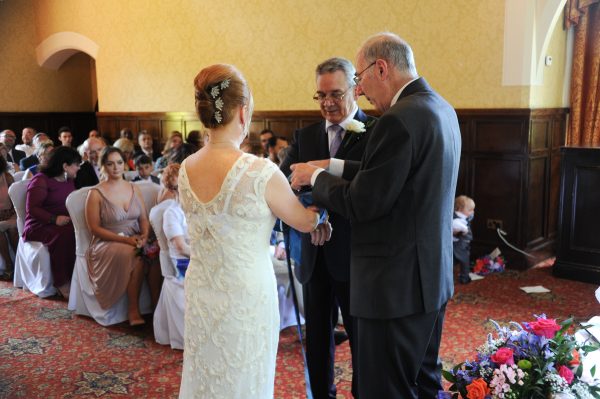
The other handfasting was at the Grim’s Dyke, which is a fabulous setting. The weather was glorious, so the ingredients were perfect. The couple, who were both on their second marriage, were initially nervous, but relaxed totally by the end, and their happiness was infectious.
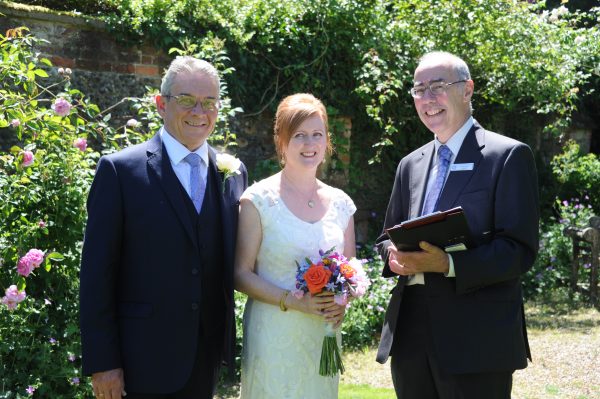
Funerals
People often ask me why I love funerals. Of course, I am sorry that people have died, and their survivors are grieving. The great thing is that I can offer a lot of help and support during the short period that I know them, and that is so satisfying.
Just one example of what I can offer comes in this testimonial:
Dear Michael,
We just wanted to say thank you for all your help and support in the last couple of weeks and during the service for Bill/Dad yesterday. Everyone we talked to said it was a lovely service.
Thank you again,
Margaret, Colin & Graham W.
So it has been a successful and enjoyable year. I have seen my business grow (though not dramatically – I still have availability for 2018!), and I am looking forward with optimism to the New Year.
May I thank you for your support and interest, and wish you all the very best for a healthy, happy and successful 2018.
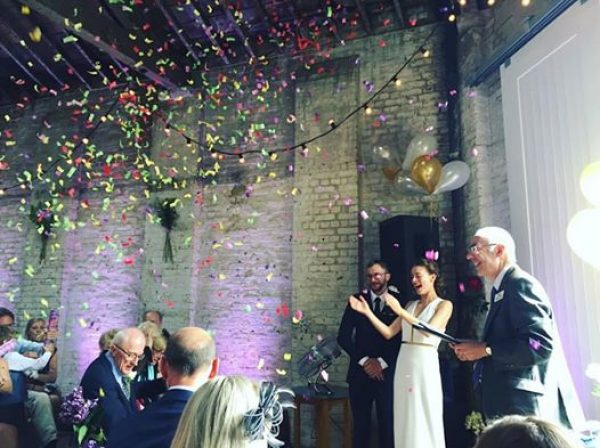
by Michael | Nov 6, 2017 | Blog
What makes a wedding ceremony stand out? What makes a unique wedding?
Of course, there are many contributory factors, such as the decor or flowers, but the ceremony itself is most likely to stick in the mind of your guests.
Maybe a unique service means a full religious one. You will know what you’re getting, so your choice will have been an informed one. But your service is likely to be conventional (rather than unique) and similar to other people’s.
If you’ve decided against a religious service, you may opt for the registrars (either at the Register Office or at a licensed venue that the registrars will come out to). As a minimum, you will need this, as this service includes the essential legal wording. The ceremony will usually last 10-15 minutes, and, however nice it may be, you will be part of a conveyor belt process. Again, not really a unique experience.
A creative option
Should you want religious elements (and you can’t or won’t use your church etc. for whatever reason), you can have a bespoke ceremony in addition to the registrars’ service.
Unlike the two types mentioned above, the civil celebrant-led ceremony will be unique. You and your celebrant will work together and compile a ceremony that reflects your beliefs and personalities, and will be everything you want it to be.
Possibilities
Examples of what you can include that may make your ceremony personal and special are: writing your own vows or putting together your story (how you met, what attracts you to each other, etc.).
However, there are many rituals which can make the ceremony stand out. They are too many to mention, but, to name but two, there could be the Unity Candle and a handfasting.
Unity Candle
You can have a special candle made, together with matching tapers. The two of you light the tapers and, together, light the Unity Candle. The symbolism is obvious! (Do take the wind into account, if it’s an outdoor wedding!)
Should you have teenage children, then they could light a taper too, and light the unity candle with you. (Similarly, you could do this in a sand ceremony.)
Handfasting

Source: louiedonovanphotography.co.uk
A handfasting is a symbolic binding of the four wrists. It can be over with in a minute or two or, in a pagan wedding, be part of a much longer ritual.
You choose a cord or ribbon of whatever colour(s) you want, but make sure it’s at least a metre long. You join hands with your partner – left hand to left, and right to right – and your wrists are then bound, as beautiful words are spoken by the celebrant. Oh, and after a while, you will be released!
So just a flavour of what you can do to make your wedding truly unique. To find out more, please contact me (07931 538487), and I’ll be delighted to help.









